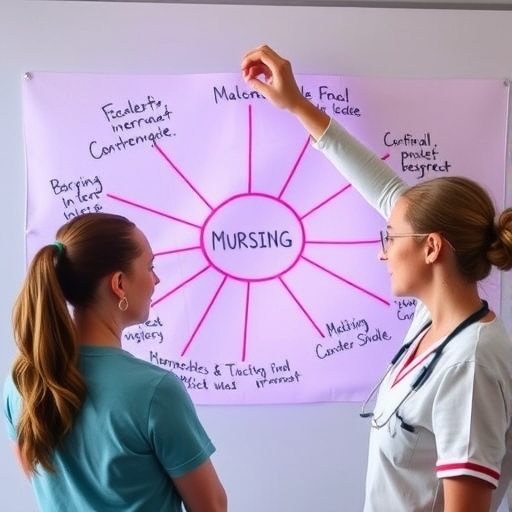
Cellular senescence is an emerging focal point in biomedical research, particularly as it relates to the mechanics of aging and various chronic diseases. This phenomenon occurs when cells cease to divide and grow, entering a state where they no longer replicate but remain metabolically active. This disruption in cellular function has been implicated in several significant health concerns, including cardiovascular disease, Alzheimer’s disease, and other age-related conditions. The challenge, however, lies in pinpointing these senescent cells amidst a vast array of healthy cells, often complicating research efforts and therapeutic interventions.
To address this challenge, a groundbreaking software platform named SenePy has been developed by a doctoral student at the University of Illinois Chicago, Mark Sanborn, in collaboration with other researchers from the College of Medicine. Their findings, which have been published in Nature Communications, aim to provide scientists with a robust tool for identifying senescent cells across various tissues and organs. This open-source platform represents a significant step forward in the pursuit of understanding and combating the effects of cellular aging.
The concept behind SenePy originates from extensive analysis of single-cell sequencing data, amounting to over 1.6 million cells from both human and mouse models. This vast dataset allowed the team to uncover genetic signatures that distinctly characterize aging cells in comparison to their healthier counterparts. Such signatures are invaluable as they open the door for greater specificity in research regarding the role of senescent cells in multiple disease pathways.
One of the crucial revelations of this research is that senescent cells possess varying genetic profiles depending on their tissue origin. The team identified 72 signatures from mice and 64 signatures from human cells, highlighting the need for a nuanced approach when investigating aging cells in different biological contexts. SenePy effectively catalogues these diverse signatures, serving as a comparative reference point for researchers examining their tissue samples.
The accessibility of SenePy is designed to enhance collaborative research efforts within the scientific community. As an open-source tool, it empowers a wider range of researchers to analyze senescent cells without the barriers often associated with proprietary software. This democratization of research tools is expected to catalyze a more profound understanding of senescence and its implications for human health.
In their work outlined in Nature Communications, the research team leveraged SenePy to delve into the roles of senescent cells in various health scenarios, including cancer progression, recovery from heart attacks, complications following COVID-19 infections, and the management of brain inflammation. Their investigations reveal a consistent pattern: senescent cells often congregate, indicating that the dysfunction and senescence in one cell can trigger a cascade effect, impacting neighboring cells adversely.
The insights gained from using SenePy not only illustrate the profound interconnectedness of cellular health but also elucidate senescence’s role as a natural protective mechanism against malignancy. The research highlighted the notion that while senescence can serve to suppress tumor formation, excessive activation of oncogenes results in heightened senescence scores, complicating the understanding of its dual nature in cancer biology.
Furthermore, the exploration of senolytic therapies—drugs aimed at eliminating senescent cells—stands to benefit significantly from the findings associated with SenePy. The identification of specific markers for various hastening forms of cellular aging enables the potential development of new senolytic agents tailored to target precise cellular dysfunctions. This advancement represents a crucial facet of therapeutic innovation aimed at combating age-related diseases.
In addition to these findings, the researchers, including Xinge Wang, Shang Gao, and Yang Dai, emphasize the broader implications of SenePy in advancing the field of gerontology and regenerative medicine. With aging populations becoming a prominent demographic concern, tools that facilitate the identification and characterization of senescent cells are paramount in driving forward discussions on healthspan and lifespan extension.
The research underlying SenePy was made possible through the support of grants from the National Institutes of Health, underscoring the importance of funding in the pursuit of scientific discovery. As researchers continue to unravel the complexities surrounding cellular senescence, tools like SenePy are poised to play a pivotal role in shaping the future landscape of health research and disease prevention.
In parallel with the sensational findings related to senescence, the broader narrative of aging and its associated pathologies drives home the urgency for further exploration and understanding. The development of innovative tools is not just a scientific milestone; it is a beacon of hope for millions affected by age-related diseases, providing novel avenues for intervention and treatment.
Ultimately, the implications of SenePy extend beyond academia; they touch upon the collective aspiration of enhancing human health and longevity. As researchers delve deeper into the signals that define senescent cells, the prospect of translating these findings into effective therapeutic strategies grows, potentially saving lives and improving the quality of life for countless individuals.
The journey forward is undoubtedly multifaceted, as researchers embrace the challenges of unraveling the complexities of cellular aging. SenePy stands at the forefront of this undertaking, promising to catalyze a new era of understanding in health science, where answers to age-old questions about senescence may finally come within reach.
Subject of Research: Cellular Senescence and its Implications for Aging and Disease
Article Title: Unveiling the cell-type-specific landscape of cellular senescence through single-cell transcriptomics using SenePy
News Publication Date: 22-Feb-2025
Web References: Nature Communications
References: SenePy GitHub Repository
Image Credits: N/A
Keywords: Cancer, Cardiovascular Disease, Aging Populations, Cellular Senescence, Senolytics, Healthspan, Regenerative Medicine.
Tags: age-related health conditionsaging cells softwareAlzheimer’s disease and cell agingbiomedical research innovationscardiovascular disease and agingcellular senescence identificationchronic disease research toolshealth risks of senescent cellsopen-source biomedical softwareSenePy software platformsingle-cell sequencing analysisUniversity of Illinois Chicago research





